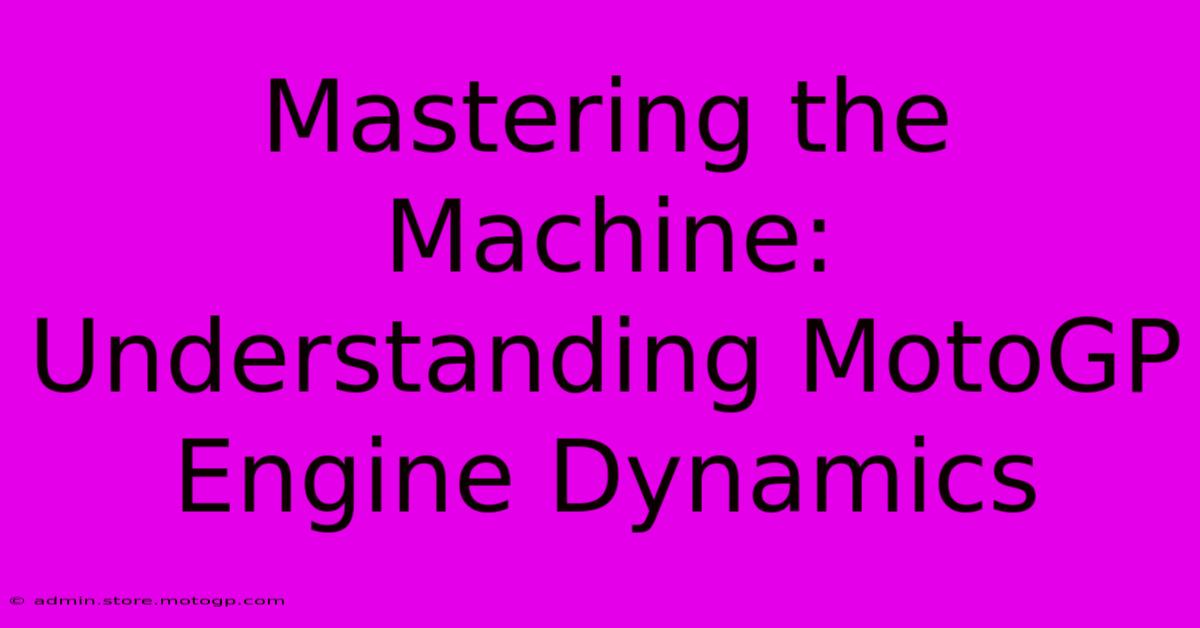Mastering The Machine: Understanding MotoGP Engine Dynamics

Table of Contents
Mastering the Machine: Understanding MotoGP Engine Dynamics
The roar of a MotoGP engine is iconic, a symphony of controlled chaos that propels riders to breathtaking speeds. But beneath the raw power lies a complex interplay of engineering marvels. Understanding the dynamics of these incredible machines is crucial to appreciating the skill of both the riders and the engineers who create them. This article dives deep into the heart of MotoGP engine technology, exploring its intricacies and the factors that contribute to its unparalleled performance.
The Heart of the Beast: Engine Specifications
MotoGP engines are a marvel of modern engineering, representing the pinnacle of internal combustion technology. These are highly-tuned inline four-cylinder engines, typically boasting a displacement of 1000cc. However, regulations constantly evolve, influencing engine characteristics and performance capabilities.
Key Engine Characteristics:
- High RPM: MotoGP engines rev incredibly high, typically exceeding 16,000 RPM, generating immense power within a narrow power band. This necessitates incredibly precise engineering and robust materials to withstand such extreme forces.
- Lightweight Construction: Weight is the enemy of speed. These engines are meticulously engineered for minimal weight, utilizing exotic materials like titanium and magnesium to achieve optimal power-to-weight ratios.
- Sophisticated Electronics: Modern MotoGP bikes rely heavily on sophisticated electronics, including advanced engine management systems (EMS) that control fuel injection, ignition timing, and other critical parameters in real time. These systems constantly adjust engine performance based on track conditions and rider input.
- Pneumatic Valves: Many MotoGP teams employ pneumatic valve actuation systems. These systems use compressed air to control valve opening and closing, enabling faster valve response times and higher RPM capabilities than conventional camshaft-driven systems. This allows for more precise control of the air-fuel mixture, resulting in increased power and efficiency.
- Seamless Shift Transmission: Quick gear changes are critical for maintaining speed and momentum on the track. MotoGP bikes utilize seamless shift transmission (SST) systems. These allow for clutchless upshifts and downshifts, eliminating the need for the rider to operate the clutch lever, allowing for smoother transitions and improved lap times.
Beyond the Basics: Understanding Engine Performance
The sheer power of a MotoGP engine is not just about raw horsepower; it's about the precise delivery of that power. Several factors contribute to this:
Power Delivery and Torque Curve:
The torque curve – the relationship between engine speed and torque output – is carefully engineered for optimal track performance. MotoGP engines are designed to deliver peak torque at a relatively high RPM, requiring the rider to maintain a high engine speed to maximize acceleration out of corners. This requires exceptional rider skill and bike control.
Aerodynamics and Chassis Integration:
The engine isn't an isolated system; it's an integral part of the entire motorcycle. The chassis, aerodynamics, and electronics all work in concert to optimize performance. The engine's position and weight distribution directly influence the bike's handling characteristics, making seamless integration crucial for competitive racing.
Maintaining Peak Performance:
The extreme conditions of MotoGP racing demand meticulous engine maintenance. Regular inspections, adjustments, and component replacements are essential to maintaining peak performance and reliability. The teams employ highly skilled technicians and engineers who monitor every aspect of the engine's performance, constantly seeking ways to improve its efficiency and power output.
The Future of MotoGP Engine Technology
MotoGP engine technology is constantly evolving. Future developments may include:
- Hybrid Systems: The integration of hybrid technology could further enhance performance and efficiency, although regulations play a significant role in determining their implementation.
- Sustainable Fuels: The ongoing push for sustainability in motorsport is likely to lead to the exploration and adoption of more environmentally friendly fuels.
- Advanced Materials: The use of lighter, stronger, and more heat-resistant materials will continue to push the boundaries of engine performance.
Mastering the machine in MotoGP requires a deep understanding not just of the rider's skills but also of the incredible engineering prowess that goes into creating these high-performance engines. The relentless pursuit of optimization and innovation continues to drive the evolution of these remarkable machines, ensuring that the roar of a MotoGP engine remains a testament to human ingenuity and the thrill of speed.

Thank you for visiting our website wich cover about Mastering The Machine: Understanding MotoGP Engine Dynamics. We hope the information provided has been useful to you. Feel free to contact us if you have any questions or need further assistance. See you next time and dont miss to bookmark.
Featured Posts
-
F1 Tomorrow The Starting Grid Whos In The Best Position
Feb 19, 2025
-
Moto Gp Watch The Best Of Moto Gp
Feb 19, 2025
-
Sprint Race Results A New Era Of Racing Begins
Feb 19, 2025
-
Austin Sprint Race Time From Beginner To Pro
Feb 19, 2025
-
The Art Of Speed Cota Track Day
Feb 19, 2025
